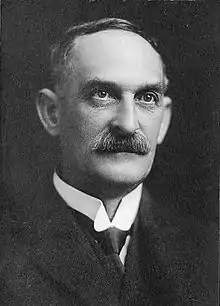Sir William Nosworthy | |
|---|---|
 | |
| 4th Minister of External Affairs | |
| In office 24 May 1926 – 24 August 1928 | |
| Prime Minister | Gordon Coates |
| Preceded by | Francis Bell |
| Succeeded by | Gordon Coates |
| 23rd Minister of Finance | |
| In office 14 May 1925 – 24 May 1926 | |
| Prime Minister | Francis Bell Gordon Coates |
| Preceded by | William Massey |
| Succeeded by | William Downie Stewart |
| 8th Minister of Agriculture | |
| In office 4 September 1919 – 21 January 1926 | |
| Prime Minister | William Massey Francis Bell Gordon Coates |
| Preceded by | William MacDonald |
| Succeeded by | Oswald Hawken |
| Member of the New Zealand Parliament for Ashburton | |
| In office 2 December 1908 – 14 November 1928 | |
| Preceded by | John McLachlan |
| Succeeded by | electorate abolished |
| Personal details | |
| Born | 18 October 1867 Christchurch, New Zealand |
| Died | 26 September 1946 (aged 78) Ashburton, New Zealand |
| Political party | Reform |
| Spouse |
Lilian Kate Wright (m. 1909) |
| Relations | Edward George Wright (father-in-law) |
Sir William Nosworthy KCMG (18 October 1867 – 26 September 1946) was a New Zealand politician. He briefly served as Minister of Finance and then Minister of External Affairs in the Reform Government.
Biography
Early life
Nosworthy was born on 18 October 1867 at the Christchurch suburb of St Albans. He was educated at private schools including Christchurch Boys' High School. He was then a farmer at Amuri and Gisborne. In 1895 he returned to Canterbury and farmed with his brother at Waitohi Downs. In 1900 they purchased Whakara, part of the Anama station. In 1917 he purchased the Mesopotamia Station initially owned by the novelist Samuel Butler.[1]
He married Lilian Kate Wright, daughter of Edward George Wright. They had no children.[1]
Political career
| Years | Term | Electorate | Party | ||
|---|---|---|---|---|---|
| 1908–1909 | 18th | Ashburton | Independent | ||
| 1909–1911 | Changed allegiance to: | Reform | |||
| 1911–1914 | 19th | Ashburton | Reform | ||
| 1914–1919 | 20th | Ashburton | Reform | ||
| 1919–1922 | 21st | Ashburton | Reform | ||
| 1922–1925 | 22nd | Ashburton | Reform | ||
| 1925–1928 | 23rd | Ashburton | Reform | ||
Nosworthy stood in the Ashburton electorate in the 1908 election. The Second Ballot Act was in force and on election night, he was in third place behind David Jones. Nosworthy encouraged his supporters to vote for Jones in the second ballot. After a recount, the situation was reversed (Nosworthy was 30 votes ahead) and Jones advertised for his supporters to vote for Nosworthy, and indeed, Nosworthy was successful in the second ballot.[2][3] In 1912 he became the junior government whip.[4]
He was first appointed to Cabinet in 1919, being appointed Minister of Agriculture (1919–1925) and then Minister of Immigration (1920–1925) by Prime Minister William Massey.[5] When Massey died in 1925, Nosworthy gained the more important role of Minister of Finance in the interim government of Francis Bell.[6]
Nosworthy contested the leadership ballot to succeed Massey, but was defeated by Gordon Coates.[7] He continued to serve as Minister of Finance until the following year, when he was given the Minister of External Affairs portfolio instead (1926–1928). He held this position until 1928.[8][9] There was rumours that Coates wished to drop Nosworthy from cabinet in his post-1925 election reshuffle. Newspapers thought he along with several others would be dropped and the Governor-General, Sir Charles Fergusson, also disliked Nosworthy thinking him 'boring'. However as Coates had entered cabinet at the same time as Nosworthy and in recognition that he had stood for the leadership, Coates thought it would be too bad of a look to dump him as a minister.[10] As Minister of External Affairs he was in charge of Samoa where disaffection among locals with the Mau movement. He opposed the movement demand for self governance and determination, supporting the Administrator of Western Samoa, George Spafford Richardson, to deal with increasing civil unrest.[1]
Nosworthy retired from parliament at the 1928 election, serving through six terms of Parliament.[3]
He was appointed a Knight Commander of the Order of St Michael and St George in the 1929 New Year Honours,[11] and was awarded the King George V Silver Jubilee Medal in 1935.[12]
Later life and death
He died at his home on 26 September 1946 in Ashburton, aged 78. He was survived by his wife.[1]
Notes
- 1 2 3 4 "Sir W. Nosworthy - Obituary". The Northern Advocate. 26 September 1946. p. 6.
- ↑ "The Ashburton Seat". The Press. Vol. LXIV, no. 13278. 20 November 1908. p. 6. Retrieved 23 November 2013.
- 1 2 Wilson 1985, p. 223.
- ↑ Wilson 1985, p. 279.
- ↑ Wilson 1985, p. 77.
- ↑ Wilson 1985, p. 78.
- ↑ Bassett 1995, p. 92.
- ↑ Wilson 1985, p. 79.
- ↑ New Zealand Parliamentary Debates, Vols 211-219 (1926-1928).
- ↑ Bassett 1995, p. 104.
- ↑ "No. 33472". The London Gazette (2nd supplement). 1 March 1929. p. 1439.
- ↑ "Official jubilee medals". The Evening Post. Vol. CXIX, no. 105. 6 May 1935. p. 4. Retrieved 17 November 2013.
References
- Bassett, Michael (1995). Coates of Kaipara. Auckland: Auckland University Press. ISBN 1-86940-117-4.
- Wilson, James Oakley (1985) [First ed. published 1913]. New Zealand Parliamentary Record, 1840–1984 (4th ed.). Wellington: V.R. Ward, Govt. Printer. OCLC 154283103.